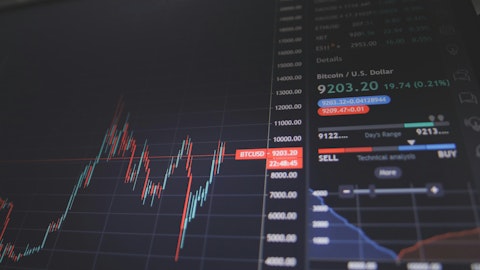In this article, we look at the 20 Countries with the Highest Purchasing Power Parity in the World in 2024.
Regional GDP Comparisons: The Role of GDP (PPP) in Economic Forecasting
Purchasing Power Parity is the rate at which the currency of one country would have to be converted into that of another country to buy the same amount of goods and services in each country. For example, a haircut in New York is more expensive than in Delhi, a taxi ride costs more in Paris than in China, and a cricket game ticket is pricier in London than in Lahore. This price disparity is due to lower wages in underdeveloped countries, making services, which are labor-intensive, less expensive. Ignoring these price differences underestimates the purchasing power of consumers in emerging and developing countries. Therefore, PPP is generally considered a better measure of overall comparison.
When international financial institutions produce regional and global statistics using aggregate data from numerous countries it is converted from its national currency to a common currency, typically the US dollar. There are two main methods for this conversion: market exchange rates and purchasing power parity (PPP) exchange rates. Market exchange rates are the rates prevailing in the foreign exchange market, whereas PPP exchange rates reflect the rate at which one country’s currency would need to be converted to another’s to purchase the same amount of goods and services in each country.
GDP at PPP utilizes PPP exchange rates to convert a country’s nominal GDP into a common currency, allowing for more accurate comparisons of economic output and living standards across nations. Adjusting GDP figures for differences in price levels and purchasing power provides a more accurate representation of the real value of goods and services produced, reflecting actual living standards and economic well-being. It accounts for the lower cost of non-traded goods and services in low-income countries offers more stability over time compared to market exchange rates and helps forecast economic comparisons more efficiently. Whereas, market-based rates only reflect internationally traded goods, ignoring the fact that non-traded goods and services are often cheaper in low-income countries compared to high-income ones.
International organizations rely on GDP at PPP for global and regional economic analysis, forecasting, and policy recommendations. Despite its advantages, calculating PPP is complex and can be subject to measurement challenges, potentially affecting the accuracy of GDP at PPP figures. However, GDP (PPP) creates a more equitable basis for comparing economies with different currencies and price levels.
The Asia and Pacific region has the highest GDP (PPP) with $85.49 trillion. This is followed by East Asia at $47.49 trillion, the Western Hemisphere at $44.76 trillion, Europe at $38.3 trillion, and North America at $34.82 trillion.
Major Company Shaping the Global Economy
The companies that contribute the most to the global economy based on purchasing power parity (PPP) include leading corporations such as Alibaba Group Holding Limited (NYSE:BABA). The company has a significant economic influence due to its extensive operations, market reach, economic activity, and growth.
Alibaba Group Holding Limited (NYSE:BABA) is a multinational conglomerate specializing in e-commerce, payment processing, logistics, retail, internet, and technology services. In addition to its core business areas, Alibaba Group Holding Limited (NYSE:BABA) has a presence in digital media, entertainment, and cloud computing and offers streaming services and online video and music streaming platforms. The company operates China’s largest wholesale marketplace and offers products in over 40 categories to buyers in more than 190 countries. Alibaba Group Holding Limited (NYSE:BABA) is also actively involved in artificial intelligence research and development.
On May 14, Alibaba Group Holding Limited (NYSE:BABA) reported that its revenue for the three months ending on March 31, increased 8% year-on-year to $33.26 billion. The company beat its revenue estimate by $256.74 million. Taobao and Tmall Group reported the highest revenue which increased by 4% to $12.81 billion. Alibaba International Digital Commerce Group reported the highest growth with revenue reaching $3.77 billion with a 45% increase compared to the same quarter in the previous year. During the quarter Alibaba Group Holding Limited (NYSE:BABA) repurchased a total of 524 million ordinary shares in the United States and Hong Kong markets for a total of $4.8 billion. Analysts predict that for the quarter ending on June 30, Alibaba Group Holding Limited’s (NYSE:BABA) revenue is expected to reach $33.95 billion.
Alibaba Group Holding Limited (NYSE:BABA) is focusing on its AI technology and continuously improving user experience and efficiency in areas such as cross-platform product listing, optimization of product details, targeted recommendations, and multilingual search. An increasing number of small- and medium-sized enterprises (SMEs) on the platform are to leveraging AI services and over 17,000 SMEs have already subscribed to the AI Business Assistant launched on Alibaba.com due to this, searches for AI-optimized products have increased by 37%. On May 24, Alibaba Group Holding Limited (NYSE:BABA) announced plans to establish new availability zones and significantly increase global investment to promote AI innovation and development. During a recent global summit held in Paris, the company revealed its plan to set up its first cloud region in Mexico and expand data centers in Malaysia, the Philippines, Thailand, and South Korea over the next three years. By increasing investment in cloud computing and artificial intelligence (AI) infrastructure across major international markets, Alibaba Cloud aims to offer a broader array of cloud computing and AI products to customers all around the world.
Purchasing Power Parity (PPP) is a crucial tool for making accurate and equitable economic comparisons across countries with different currencies and price levels. By considering the varying costs of goods and services, GDP at PPP offers a more realistic view of economic output and living standards, particularly in low-income and emerging markets. With that in context let’s look at the 20 countries with the highest purchasing power parity in the world in 2024.

Pixabay/Public domain
Our Methodology
To compile our list of the 20 countries with the highest purchasing power parity in the world in 2024, we sourced data from the International Monetary Fund (IMF). IMF provides data for the Gross Domestic Product (GDP) and the percentage share of the world according to purchasing power parity (PPP) in 2024. We also sourced the GDP per capita (PPP) from the IMF and the population of these countries from the United Nations. Our list ranks the 20 countries with the highest purchasing power parity in the world in 2024 in ascending order of their GDP (PPP).
By the way, Insider Monkey is an investing website that uses a consensus approach to identify the best stock picks of more than 900 hedge funds investing in US stocks. The website tracks the movement of corporate insiders and hedge funds. Our top 10 consensus stock picks of hedge funds outperformed the S&P 500 stock index by more than 140 percentage points over the last 10 years (see the details here). So, if you are looking for the best stock picks to buy, you can benefit from the wisdom of hedge funds and corporate insiders.
20 Countries with the Highest Purchasing Power Parity in the World in 2024
20. Poland
GDP (PPP): $1.80 Trillion
Estimated Share in the Global GDP (PPP): 0.97%
Poland’s economy is growing rapidly and has a 0.97% stake with a GDP based on purchasing power parity (PPP) of $1.80 trillion. Poland has shifted itself to industrial and service sectors over the past few decades and has automotive, electronics, machinery, and IT industries. The country’s per capita PPP GDP stands at $49,060 and has a population of 40.22 million.
19. Iran
GDP (PPP): $1.85 Trillion
Estimated Share in the Global GDP (PPP): 1.00%
Iran is the second largest economy in the Middle East and is known for its vast oil and natural gas reserves which contribute to its GDP (PPP) of $1.85 trillion with a 1% stake in the global GDP. Despite its wealth in natural resources, Iran faces economic challenges due to international sanctions which impacts its ability to engage fully in global trade. Iran has a population of 89.81 million and a GDP per capita PPP of $21,220.
18. Egypt
GDP (PPP): $1.90 Trillion
Estimated Share in the Global GDP (PPP): 1.02%
Egypt has the largest economy in Africa with a GDP (PPP) of $1.90 trillion and GDP (PPP) per capita of $17,610. Egypt has a population of 114.48 million and accounts for 1.02% of the global GDP (PPP).
17. Saudi Arabia
GDP (PPP): $2.35 Trillion
Estimated Share in the Global GDP (PPP): 1.27%
Saudi Arabia is the largest economy in the Middle East with a GDP of $2.35 trillion based on purchasing power parity. The country has a per capita PPP GDP of $70,330. Under its Vision 2030 initiative, Saudi Arabia is striving to diversify its economy by investing in sectors such as tourism, entertainment, and renewable energy. Saudia Arabia has a population of 37.47 million.
16. Canada
GDP (PPP): $2.47 Trillion
Estimated Share in the Global GDP (PPP): 1.33%
Canada is the second largest country in the world by land area and has a highly developed and diversified economy with a GDP of $2.47 trillion based on purchasing power parity. Canada has a population of 39.11 million and has a high standard of living with a GDP per capita PPP of $60,500.
15. Spain
GDP (PPP): $2.52 Trillion
Estimated Share in the Global GDP (PPP): 1.36%
Spain has a GDP based on purchasing power parity of $2.52 trillion and accounts for 1.36% of the global GDP (PPP). Spain has a population of 47.47 million and a per capita PPP GDP of $52,010.
14. South Korea
GDP (PPP): $3.06 Trillion
Estimated Share in the Global GDP (PPP): 1.65%
South Korea is known for its advanced technology and manufacturing sectors including electronics, automobiles, and shipbuilding. South Korea has a per capita PPP GDP of $59,330 and a population of 26.24 million. South Korea has transformed into a high-income economy with a GDP of $3.06 trillion based on purchasing power parity and has a global share of 1.65%.
13. Italy
GDP (PPP): $3.35 Trillion
Estimated Share in the Global GDP (PPP): 1.80%
Italy’s economy accounts for 1.80% with a GDP of $3.35 trillion based on purchasing power parity. The country is known for its luxury goods, automotive industry, and strong agricultural sector, particularly in wine and olive oil production. Italy is a key player in the European Union and has a population of 58.70 million. Italy has a per capita PPP GDP of $56,910.
12. Mexico
GDP (PPP): $3.43 Trillion
Estimated Share in the Global GDP (PPP): 1.85%
Mexico has a population of 129.39 million and a per capita PPP GDP is $25,960. Mexico has a diverse economy and has a 1.85% share in the global GDP (PPP) with a GDP based on purchasing power parity of $3.43 trillion. The country benefits from its strategic location and strong trade relations with the United States and Canada through the USMCA agreement. Mexico’s automotive industry is also emerging as a significant exporter.
11. Turkiye
GDP (PPP): $3.83 Trillion
Estimated Share in the Global GDP (PPP): 2.06%
Turkiye has an emerging automotive, electronics, and petrochemical sector. The per capita PPP GDP is $43,920 for its population of 86.26 million. Turkiye is strategically located at the crossroads of Europe and Asia, which enhances its trade prospects but faces economic challenges such as high inflation. Turkiye’s economy is a mix of modern industry and commerce along with a traditional agriculture sector and holds a 2.06% share in the global GDP (PPP) with a GDP of $3.83 trillion based on purchasing power parity.
10. France
GDP (PPP): $3.99 Trillion
Estimated Share in the Global GDP (PPP): 2.15%
France has a per capita PPP GDP of $60,340 and a population of 64.88 million. France is one of the largest economies in Europe and has a GDP of $3.99 trillion based on purchasing power parity which accounts for 2.15% of the global GDP by PPP. France is a leading global exporter of luxury goods, aerospace products, and agricultural products like wine and cheese.
9. United Kingdom
GDP (PPP): $4.03 Trillion
Estimated Share in the Global GDP (PPP): 2.17%
The United Kingdom has a highly developed and diversified economy with a GDP of $4.03 trillion based on purchasing power parity. The economy is driven by its strong financial services sector, particularly in London. The United Kingdom has a population of 67.96 million, and a GDP per capita PPP of $58,880. The United Kingdom accounts for 2.17% of the global GDP (PPP). Despite recent economic and political challenges, the country remains a major global economic player in the world.
8. Brazil
GDP (PPP): $4.27 Trillion
Estimated Share in the Global GDP (PPP): 2.30%
Brazil is the largest economy in South America and has a GDP (PPP) of $4.27 trillion which accounts for 2.30% of the global GDP (PPP). The economy is Brazil is diverse and has a strong agriculture, mining, manufacturing, and services industry. Brazil is a leading exporter of commodities such as soybeans, coffee, and iron ore. The population of Brazil is 217.64 million, whereas the country has a per capita PPP GDP of $20,810.
7. Indonesia
GDP (PPP): $4.72 Trillion
Estimated Share in the Global GDP (PPP): 2.54%
Indonesia’s economy has a GDP based on purchasing power parity of $4.72 trillion which is the largest in Southeast Asia and represents 2.54% of the global GDP (PPP). Indonesia’s economy is characterized by its diverse economic structure, including agriculture, manufacturing, and services, and is a major exporter of natural resources like coal, palm oil, and rubber. Indonesia is one the largest countries in South East Asia and has a population of 279.80 million. Indonesia has a per capita PPP GDP of $16,860.
6. Russia
GDP (PPP): $5.47 Trillion
Estimated Share in the Global GDP (PPP): 2.95%
Russia, the largest country in the world is rich in natural resources, particularly oil, gas, and minerals, and has a GDP of $5.47 trillion based on purchasing power parity. The country also has a significant manufacturing sector, including the aerospace and defense industries. Russia has a population of 143.96 million and has a per capita PPP GDP of $38,290. Despite facing economic sanctions Russia remains a major global player. 2.95% of the global GDP (PPP) is secured by Russia.
5. Germany
GDP (PPP): $5.69 Trillion
Estimated Share in the Global GDP (PPP): 3.06%
Germany is a leading exporter of high-quality goods and has a significant services sector. The country has a population of 83.25 million, and a per capita PPP GDP of $67,240. Germany is one of the largest in Europe and has a 3.06% share in the global GDP (PPP) of $5.69 trillion. Germany is known for its strong industrial base, particularly in the automotive, engineering, and chemical industries.
4. Japan
GDP (PPP): $6.72 Trillion
Estimated Share in the Global GDP (PPP): 3.62%
Japan has a highly advanced economy with a GDP of $6.72 trillion based on purchasing power parity. Japan is known for its strong manufacturing sector, particularly in electronics, automobiles, and robotics. Japan is a global leader in technology and innovation, with significant investments in research and development. Japan has a population of 122.63 million and has a per capita PPP GDP of $54,180. Japan holds a 3.62% of the global GDP (PPP). The country faces challenges like an aging population but remains a major economic power.
3. India
GDP (PPP): $14.59 Trillion
Estimated Share in the Global GDP (PPP): 7.86%
India is one of the fastest-growing economies in the world and has a GDP of $14.59 trillion based on purchasing power parity which accounts for 7.86% of the global GDP (PPP). India’s growth is characterized by its diverse economic structure, including agriculture, manufacturing, and services. India is a major exporter of software services and has a rapidly expanding technology sector. India is the largest country in the world and has a population of 1.44 billion and a per capita PPP GDP of $10,120.
2. United States
GDP (PPP): $28.78 Trillion
Estimated Share in the Global GDP (PPP): 15.50%
The United States has the second largest economy in the world, with a GDP of $28.78 trillion based on purchasing power parity in the world in 2024. The US economy is highly diversified and is a global leader in technology, finance, innovation, entrepreneurship, and services. The United States has a population of 341.81 million and a per capita PPP GDP of $85,370. The country holds 15.50% of the global GDP (PPP) and benefits from a robust regulatory environment, strong trade relations, and significant foreign investment.
1. China
GDP (PPP): $35.29 Trillion
Estimated Share in the Global GDP (PPP): 19.01%
China has the highest purchasing power parity in the world in 2024 and holds a 19.01% stake in the global GDP (PPP) based on purchasing power parity of $35.29 trillion. China is a major global exporter and has invested heavily in infrastructure and technology. China has a population of 1.43 billion and a per capita PPP GDP of $25,020. China is often regarded as the economic miracle of the world and is known for its rapid industrialization, manufacturing capacity, and growing services sector.
At Insider Monkey, we delve into a variety of topics, however, our expertise lies in identifying the top-performing stocks. Currently, Artificial Intelligence (AI) technology stands out as one of the most promising fields. If you are looking for an AI stock that is more promising than NVDA but that trades at less than 5 times its earnings, check out our report about the cheapest AI stock.
READ NEXT: Analyst Sees a New $25 Billion “Opportunity” for NVIDIA and Jim Cramer is Recommending These 10 Stocks in June.
Disclosure: None. Insider Monkey focuses on uncovering the best investment ideas of hedge funds and insiders. Please subscribe to our free daily e-newsletter to get the latest investment ideas from hedge funds’ investor letters by entering your email address below.





